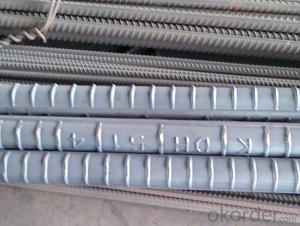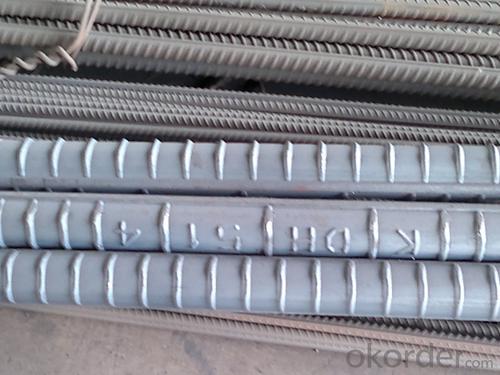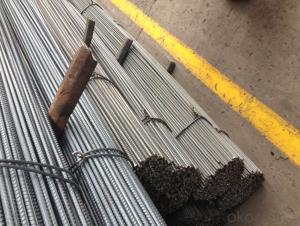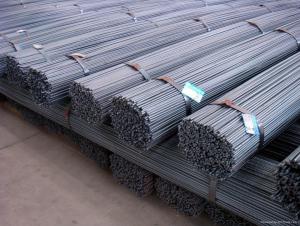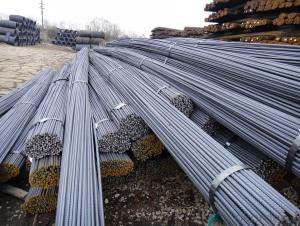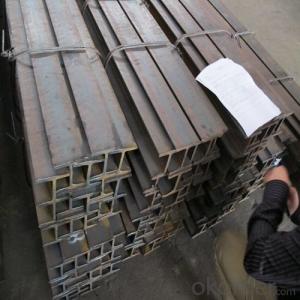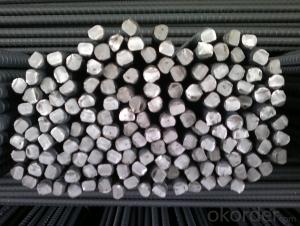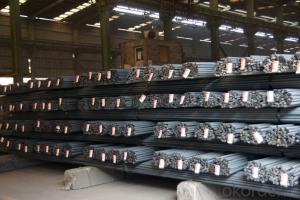Deformed steel bar HPB400; HPB500
- Loading Port:
- Tianjin
- Payment Terms:
- TT OR LC
- Min Order Qty:
- 2000 m.t.
- Supply Capability:
- 30000 m.t./month
OKorder Service Pledge
OKorder Financial Service
You Might Also Like
Specifications of Deformed Steel Bar:
Standard | GB | HRB335, HRB400, HRB500 | |
UK | G460B, B500A, B500B,B500C | ||
USA | GR40, GR60 | ||
Diameter | 6mm,8mm,10mm,12mm,14mm,16mm,18mm,20mm, 22mm,25mm,28mm,32mm,36mm,40mm,50mm | ||
Length | 6M, 9M,12M or as required | ||
Place of origin | Hebei, China mainland | ||
Application | building,construction,road,bridge etc | ||
Brand name | DRAGON | ||
Theoretical weight and section area of each diameter as below for your information:
Diameter(mm) | Section area (mm²) | Mass(kg/m) |
6 | 28.27 | 0.222 |
8 | 50.27 | 0.395 |
10 | 78.54 | 0.617 |
12 | 113.1 | 0.888 |
14 | 153.9 | 1.21 |
16 | 201.1 | 1.58 |
18 | 254.5 | 2.00 |
20 | 314.2 | 2.47 |
22 | 380.1 | 2.98 |
25 | 490.9 | 3.85 |
28 | 615.8 | 4.83 |
32 | 804.2 | 6.31 |
36 | 1018 | 7.99 |
40 | 1257 | 9.87 |
50 | 1964 | 15.42 |
Usage and Applications of Deformed Steel Bar:
Deformed bar is widely used in buildings, bridges, roads and other engineering construction. Big to highways, railways, bridges, culverts, tunnels, public facilities such as flood control, dam, small to housing construction, beam, column, wall and the foundation of the plate, deformed bar is an integral structure material. With the development of world economy and the vigorous development of infrastructure construction, real estate, the demand for deformed bar will be larger and larger..
Packaging & Delivery of Deformed Steel Bar:
Packaging Detail: products are packed in bundle and then shipped by container or bulk vessel, deformed bar is usually naked strapping delivery, when storing, please pay attention to moisture proof. The performance of rust will produce adverse effect.
Each bundle weight: 2-3MT, or as required
Payment term: TT or L/C
Delivery Detail: within 45 days after received advanced payment or LC.
Label: to be specified by customer, generally, each bundle has 1-2 labels
Trade terms: FOB, CFR, CIF
- Q: How do steel rebars contribute to the crack control in slabs and walls?
- Steel rebars contribute to crack control in slabs and walls through their ability to resist tensile forces. When concrete slabs and walls experience loads, such as the weight of the structure or external forces, they may develop tensile stresses. Concrete is strong in compression but weak in tension, making it prone to cracking under tensile forces. Steel rebars are embedded within the concrete to counteract these tensile stresses. By absorbing and distributing the tensile forces, rebars help to prevent crack formation and control their propagation. The rebars act as reinforcement, increasing the overall tensile strength of the concrete. The presence of steel rebars in slabs and walls helps to limit the width and length of cracks that may occur by providing resistance against the tensile stresses. This crack control is crucial for maintaining the structural integrity and durability of the concrete elements. Furthermore, steel rebars can also contribute to crack control by improving the overall ductility of the structure. Ductility refers to the ability of a material to deform under load without fracturing. By enhancing the ductility of the concrete, the rebars allow the structure to absorb energy and deform in a controlled manner, reducing the likelihood of sudden failure or catastrophic collapse. In summary, steel rebars play a vital role in crack control in slabs and walls by increasing the tensile strength of concrete, limiting crack width and length, and improving overall structural ductility. Their presence ensures the long-term durability and safety of these concrete elements.
- Q: What are the different types of steel rebars used in beam reinforcement?
- Different types of steel rebars are commonly utilized for beam reinforcement. These include: 1. Mild Steel Rebars (MSR): Low carbon steel is used to produce these rebars, which are widely employed due to their affordability and availability. They possess a yield strength of 250 MPa and are suitable for general construction purposes. 2. High Yield Strength Rebars (HYSD): These rebars exhibit a higher yield strength in comparison to mild steel rebars, typically ranging from 415 MPa to 600 MPa. They find common usage in heavy-duty and high-stress applications, such as bridges and high-rise buildings. 3. Carbon Steel Rebars: Carbon steel rebars are manufactured from steel with a higher carbon content than mild steel rebars. They offer enhanced strength and ductility, making them appropriate for areas prone to corrosion and seismic zones. 4. Stainless Steel Rebars: Stainless steel rebars are produced using steel with a high chromium content and other alloying elements. They possess excellent corrosion resistance, making them ideal for structures exposed to harsh environments like marine applications or chemical plants. 5. Epoxy-Coated Rebars: These rebars are coated with an epoxy layer to provide additional protection against corrosion. Epoxy-coated rebars are frequently utilized in structures exposed to moisture or chloride-rich environments, such as coastal regions or areas with deicing salts. It is crucial to consider the specific requirements and conditions of the project when selecting the type of steel rebar for beam reinforcement. It is recommended to consult with structural engineers or industry professionals to ensure the appropriate material is chosen for optimal performance and longevity of the reinforced beam.
- Q: Can steel rebars be used in underground parking garage construction?
- Yes, steel rebars can be used in underground parking garage construction. Steel rebars are commonly used in the construction of reinforced concrete structures, including underground parking garages. The rebars provide strength and reinforcement to the concrete, making it capable of withstanding the weight and pressure of the structure above. In addition, steel rebars offer excellent resistance to corrosion, which is especially important in underground environments where moisture and other corrosive elements may be present. Overall, steel rebars are a reliable and commonly used choice for reinforcing concrete in underground parking garage construction.
- Q: What are the advantages of using galvanized steel rebars?
- There are several advantages to using galvanized steel rebars in construction projects. Firstly, galvanized steel rebars have a protective zinc coating that helps to prevent corrosion. This protection extends the lifespan of the rebars, making them more durable and long-lasting. Unlike traditional steel rebars that may rust over time, the zinc coating acts as a barrier against moisture and other corrosive elements, ensuring the structural integrity of the construction. Secondly, galvanized steel rebars have a high strength-to-weight ratio. This means that they are lightweight yet incredibly strong, making them ideal for use in reinforced concrete structures. The strength of galvanized steel rebars allows for the use of thinner and lighter rebars, reducing the overall weight of the structure and making it more cost-effective. Additionally, galvanized steel rebars are easy to work with and install. They can be easily cut, bent, and shaped to fit the specific requirements of a construction project. This ease of handling allows for faster construction, saving both time and money. Furthermore, galvanized steel rebars are resistant to fire. The zinc coating on the rebars acts as a protective layer, preventing them from burning or being damaged by high temperatures. This fire resistance is crucial in ensuring the safety and stability of a structure, especially in areas prone to fires or where fire safety regulations are strict. Lastly, galvanized steel rebars are environmentally friendly. The zinc coating used in the galvanization process is non-toxic and recyclable. This means that at the end of their lifespan, galvanized steel rebars can be easily recycled and reused, reducing waste and minimizing their environmental impact. In summary, the advantages of using galvanized steel rebars include corrosion resistance, high strength-to-weight ratio, ease of installation, fire resistance, and environmental friendliness. These benefits make galvanized steel rebars a popular and reliable choice for reinforcing concrete structures in various construction projects.
- Q: Can steel rebars be used in stadium construction?
- Yes, steel rebars can be used in stadium construction. Steel rebars, which are essentially reinforcing steel bars, are commonly used in concrete construction to provide strength and stability. In stadium construction, steel rebars are extensively used in reinforced concrete structures such as columns, beams, slabs, and foundations. These rebars are placed strategically within the concrete to enhance its load-bearing capacity and to prevent cracking or failure under heavy loads and vibrations. The use of steel rebars ensures the structural integrity and durability of the stadium, making it capable of withstanding the immense pressures and forces exerted during sporting events and large gatherings of spectators.
- Q: Are there any specific guidelines for storing and handling steel rebars?
- Specific guidelines exist for the storage and handling of steel rebars. Take note of the following essential points: 1. Storage: To prevent corrosion, it is necessary to store steel rebars in an area that is clean, dry, and well-ventilated. Place them on timber or other suitable materials to keep them elevated and away from moisture. 2. Handling: Exercise caution when handling steel rebars to avoid any damage or bending. It is advised to use appropriate equipment like cranes, forklifts, or sturdy hooks for lifting and moving rebars. Dragging or dropping them should be avoided as it may cause deformations and compromise their structural integrity. 3. Bundling: Properly bundle and secure rebars together using steel wires or straps to prevent rolling or shifting during storage or transportation. This ensures stability and reduces the risk of accidents. 4. Separation: Keep different sizes and types of rebars separate and clearly labeled to prevent confusion during construction. This facilitates easy identification and utilization of the required rebar according to the structural plans. 5. Protection: Guard rebars against exposure to moisture, rain, snow, and other weather elements. When storing rebars outdoors, utilize waterproof covers or tarps to shield them and prevent the formation of rust. 6. Inspection: Regular inspections should be conducted to identify signs of corrosion, damage, or bending. Any defective or compromised rebars must be promptly removed and replaced to maintain the structural integrity of the construction project. 7. Transportation: During transportation, ensure that rebars are securely fastened and loaded onto appropriate vehicles to prevent movement or falling off. Employ sufficient padding and tie-downs to protect rebars from damage and ensure safe transportation. Adhering to these guidelines is crucial in upholding the quality, durability, and safety of steel rebars throughout their storage and handling process.
- Q: Can steel rebars be used in structures with high chemical resistance requirements?
- Steel rebars can be used in structures with high chemical resistance requirements, but it is important to consider the specific chemical environment in which the structure will be exposed. While steel rebars are generally resistant to many common chemicals, certain aggressive chemical substances, such as acids or alkaline solutions, can cause corrosion and degradation of the rebar over time. In such cases, it may be necessary to use alternative materials like stainless steel rebars or fiber-reinforced polymer (FRP) rebars, which possess superior resistance to chemical attack. Additionally, proper design, construction, and maintenance practices should be implemented to mitigate the effects of chemical exposure on steel rebars. Factors such as the type and concentration of chemicals, temperature, humidity, and exposure duration should all be carefully considered to determine the suitability of steel rebars for a structure with high chemical resistance requirements. Consulting with a structural engineer or corrosion specialist is recommended to ensure the best choice of materials for the specific chemical environment.
- Q: How do steel rebars enhance the structural integrity of a building?
- In several ways, the structural integrity of a building is enhanced by steel rebars. Firstly, they reinforce and support concrete structures, including beams, columns, and slabs, preventing cracking or collapsing under heavy loads or external forces. The high tensile strength of steel rebars enables them to bear tensile stresses that concrete alone cannot handle, guaranteeing the building's stability and durability. Furthermore, steel rebars aid in evenly distributing and transferring loads throughout the structure, reducing concentrated stress. By reinforcing critical areas prone to tension, like corners, joints, and openings, rebars prevent cracks and ensure overall stability. Steel rebars also play a vital role in improving the structure's resistance to natural disasters like earthquakes and hurricanes. The flexibility and ductility of steel allow it to absorb and dissipate energy during seismic events or high winds, minimizing the risk of structural failure. This increased resilience ensures occupant safety and protects the building from severe damage. Additionally, steel rebars offer long-term durability by shielding the structure against corrosion. Unlike other construction materials, steel is highly resistant to degradation caused by environmental factors like moisture, chemicals, and temperature fluctuations. Corrosion-resistant rebars or protective coatings can significantly extend the building's lifespan. In conclusion, steel rebars are crucial components for reinforcing concrete structures, strengthening their integrity, stability, and resilience. By providing additional support and resistance to various stresses and loads, they contribute to the overall structural integrity of a building, guaranteeing its safety, longevity, and ability to withstand adverse conditions.
- Q: Can steel rebars be used in tunneling and mining operations?
- Steel rebars have a wide range of applications, including tunneling and mining operations. These steel bars, typically used for reinforcing concrete structures, can also be utilized in underground construction projects like tunnels and mines. By incorporating rebars into these environments, additional strength and stability are provided to the structures, ensuring durability and safety. In tunneling projects, it is common to embed rebars in shotcrete or concrete linings to enhance the structural integrity of the tunnel walls and prevent collapse. Similarly, in mining operations, rebars are used to reinforce the roofs, walls, and support structures within the mine, protecting against potential hazards such as rockfalls and cave-ins. The use of steel rebars is essential in maintaining the integrity and stability of these underground structures during tunneling and mining operations.
- Q: Can steel rebars be used in structures with high resistance to UV radiation?
- Structures with high exposure to UV radiation typically do not recommend the use of steel rebars. Traditional carbon steel rebars are vulnerable to corrosion when exposed to UV radiation. The sun's rays can degrade the protective oxide layer on the surface of the steel, leading to rust and deterioration over time. Furthermore, UV radiation can cause the steel to expand and contract, weakening its overall strength and structural integrity. To address these concerns, alternative materials like stainless steel rebars or epoxy-coated rebars are commonly employed in structures that require high UV radiation resistance. Stainless steel rebars possess greater corrosion resistance and durability when exposed to UV radiation. Epoxy-coated rebars have a protective layer of epoxy coating that shields the steel from direct UV radiation, mitigating the risk of corrosion. Consulting structural engineers and professionals is crucial in determining the appropriate type of rebars for structures with high UV radiation resistance. Factors such as the specific environment, climate conditions, and project requirements should be carefully considered to ensure the structure's longevity and safety.
Send your message to us
Deformed steel bar HPB400; HPB500
- Loading Port:
- Tianjin
- Payment Terms:
- TT OR LC
- Min Order Qty:
- 2000 m.t.
- Supply Capability:
- 30000 m.t./month
OKorder Service Pledge
OKorder Financial Service
Similar products
Hot products
Hot Searches
Related keywords
